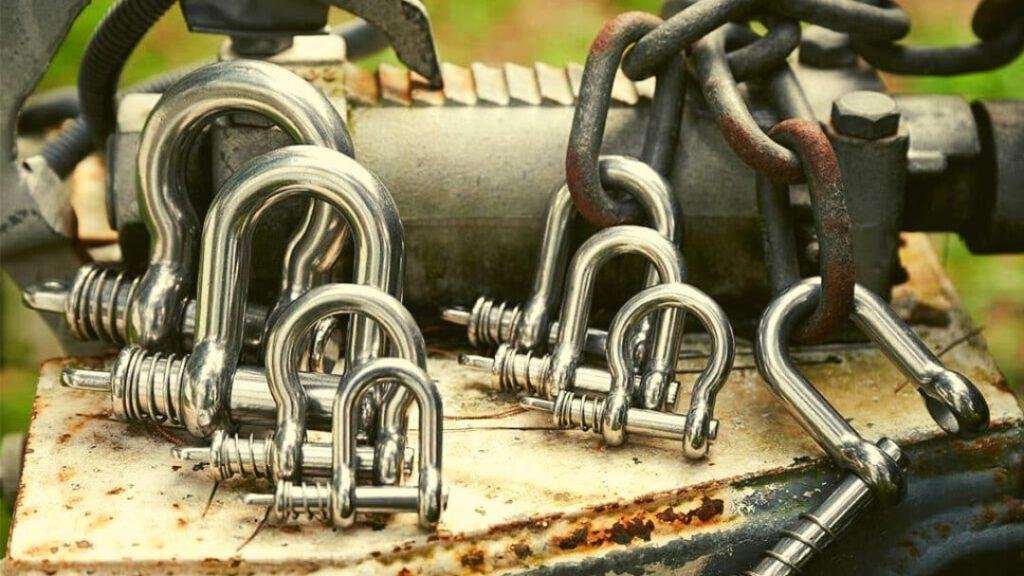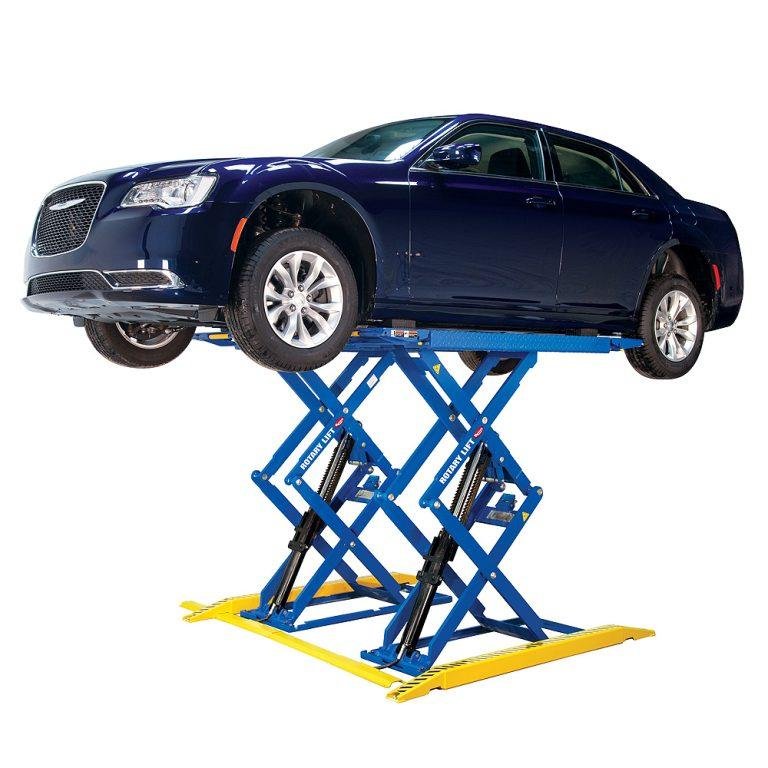A d shackle is a metal fastening device used to secure objects or connect ropes and chains. It is commonly shaped like the letter “d”, with a curved body and a pin or screw fastener.
D shackles are widely used in various industries, including maritime, construction, and rigging, due to their strength, durability, and easy-to-use design. They are often made from materials like stainless steel or alloy steel and come in different sizes and load capacities to fit specific applications.
D shackles are essential for connecting, lifting, and securing heavy loads, making them a crucial tool in many fields.
What Is A D Shackle?
A d shackle is a type of metal fastener commonly used in lifting and rigging applications. It has a d-shaped design with a pin that can be secured and removed easily, making it versatile and reliable for various tasks in industries such as construction and maritime.
What Is A D Shackle?
A d shackle, also known as a dee shackle, is a common type of shackle used in various industries for connecting lifting, towing, and rigging equipment. It is characterized by its d-shape design, with a curved, u-shaped body and a removable pin or bolt closure mechanism.
D shackles are typically made of sturdy materials like stainless steel or galvanized steel, ensuring high strength and durability.
Definition And Description Of A D Shackle:
- A d shackle is a u-shaped fastener with a removable pin, designed to provide a secure connection for lifting and rigging applications.
- These shackles are commonly made of strong materials like stainless steel or galvanized steel, enhancing their resistance to corrosion and mechanical stress.
- They are available in a range of sizes and load capacities to accommodate different working requirements.
- The d shape of the shackle allows for easy attachment of ropes, chains, or cables through its curved body.
- The pin or bolt closure mechanism ensures a secure and reliable fastening, preventing accidental disengagement.
- D shackles are known for their versatility and are widely used in industries such as construction, maritime, mining, and transportation.
Common applications and uses of d shackles:
- Lifting and rigging: D shackles are essential components in lifting and rigging operations, often used to connect hoists, slings, and other equipment.
- Towing and recovery: These shackles are frequently used in towing and recovery applications to secure ropes or chains to vehicles or recovery points.
- Off-roading and 4×4 adventures: D shackles are crucial in off-roading activities, serving as attachment points for straps, winches, or recovery equipment.
- Maritime and boating: D shackles find extensive use in maritime industries for connecting various components, such as anchor chains, ropes, and pulleys.
- Construction and building: D shackles are employed in construction sites, enabling secure connections for lifting heavy objects or securing scaffolding systems.
Importance of d shackles in various industries:
- Safety and reliability: D shackles play a critical role in ensuring the safety and reliability of lifting and rigging operations, providing a secure connection between components.
- Versatility: The adaptability of d shackles allows for their usage across a wide range of industries and applications, making them a versatile and indispensable tool.
- Durability: Made from robust materials, d shackles exhibit high strength and durability, withstanding challenging working conditions and ensuring long-lasting performance.
- Efficiency and productivity: By providing a quick and reliable connection method, d shackles contribute to improved efficiency and productivity in various industries.
- Compliance with regulations: The use of d shackles in lifting and rigging operations helps maintain compliance with industry and safety regulations, ensuring adherence to best practices.
Now that we have explored the definition, description, common applications, and importance of d shackles, it is clear why these versatile fasteners are widely used in different industries. Their reliability, durability, and ease of use make them an essential tool for secure connections in lifting, towing, and rigging operations.

Types Of D Shackles
D shackles, also known as dee shackles, are a type of fastening device commonly used in various industries. They are designed in the shape of the letter “d” and are typically used to connect and secure lifting equipment, ropes, and chains.
Types Of D Shackles
D shackles are a type of rigging hardware commonly used in various industries for connecting, lifting, and securing loads. They are named after their distinctive d-shaped design, which provides a strong and secure connection. In this section, we will explore three types of d shackles: screw pin d shackles, bolt type d shackles, and safety bolt type d shackles.
Each type has its own unique features, benefits, and suitable applications.
Screw Pin D Shackles
- Versatile and widely used in many applications due to their simplicity and ease of use.
- Feature a screw pin that can be easily tightened and loosened by hand.
- Made from high-quality materials to ensure strength and durability.
- Can be used for lifting, towing, and securing loads in a variety of settings.
Features And Benefits
- Durable construction: Screw pin d shackles are built to withstand heavy loads and are resistant to corrosion and weathering.
- Ease of use: The screw pin design allows for quick and hassle-free assembly, disassembly, and adjustment.
- Versatility: These shackles can be used in various industries such as construction, marine, and agriculture.
- Cost-effective: Screw pin d shackles are affordable and offer excellent value for money.
- Widely available: These shackles are readily available in different sizes and capacities to suit specific needs.
Suitable Applications
- Lifting and hoisting equipment in construction sites or industrial settings.
- Securing loads on trucks, trailers, and boats.
- Connecting chains, ropes, or cables.
- Rigging in outdoor and marine environments.
Bolt Type D Shackles
- Designed with a bolt and nut mechanism for a secure and dependable connection.
- Feature a larger pin diameter and a higher working load limit compared to screw pin d shackles.
- Provide increased safety and stability in heavy-duty applications.
- Ideal for demanding tasks that require exceptional strength and reliability.
Features And Benefits
- High load capacity: Bolt type d shackles are engineered to handle heavy loads and offer a large working load limit.
- Enhanced safety: The bolt and nut mechanism ensures a secure connection, reducing the risk of accidental disengagement.
- Built to last: These shackles are made from robust materials, making them resistant to wear, deformation, and corrosion.
- Suitable for extreme conditions: Bolt type d shackles can withstand harsh environments, including high temperatures and corrosive substances.
- Versatile applications: Used in construction, mining, oil and gas, and other heavy-duty industries.
Suitable Applications
- Rigging for cranes, lifts, and heavy machinery.
- Securing equipment and loads in offshore and marine environments.
- Heavy-duty applications in mining, construction, and industrial settings.
Safety Bolt Type D Shackles
- Similar to bolt type d shackles but with an added safety feature.
- Include a threaded safety bolt that prevents the pin from loosening or disengaging accidentally.
- Recommended for critical operations or applications that involve significant loads and potential hazards.
- Ensure an extra level of security and peace of mind.
Features And Benefits
- Secure connection: The threaded safety bolt provides a locking mechanism that prevents accidental pin release.
- Reliable and durable: Safety bolt type d shackles are constructed to withstand extreme force and harsh conditions.
- Increased safety: The added safety feature minimizes the risk of accidents or load failures.
- Wide range of applications: Suitable for critical operations in industries such as construction, mining, and heavy machinery.
Suitable Applications
- Lifting heavy loads in construction and engineering projects.
- Rigging in oil and gas refineries or chemical plants.
- Securing equipment in high-risk environments.
- Critical applications that demand maximum safety.
D shackles come in different types to cater to various requirements. Screw pin d shackles are versatile and easy to use, bolt type d shackles offer exceptional strength and reliability, while safety bolt type d shackles provide an extra level of security in critical operations.
By understanding the features, benefits, and suitable applications of each type, you can select the most appropriate d shackle for your specific needs.
Factors To Consider When Choosing A D Shackle
When choosing a d shackle, it is important to consider factors such as material quality, load capacity, and design to ensure safe and effective usage.
Factors To Consider When Choosing A D Shackle
Choosing the right d shackle for your application is crucial to ensure safety and durability. Several factors should be taken into consideration when making this decision. In this section, we will explore the key factors to keep in mind when choosing a d shackle, including material selection, working load limit (wll) and safe working load (swl), and shape and size.
Material Selection
- D shackles are available in various materials, each with its own set of advantages and disadvantages. The choice of material depends on the specific requirements of your application.
- Common materials used in the manufacturing of d shackles include stainless steel, galvanized steel, and alloy steel.
- Stainless steel d shackles offer excellent corrosion resistance and are ideal for marine and outdoor applications. They are highly durable and can withstand harsh environmental conditions.
- Galvanized steel d shackles are cost-effective and provide good resistance against corrosion. They are commonly used in industrial and heavy-duty applications.
- Alloy steel d shackles offer exceptional strength and are often used in applications where high load capacities are required.
Pros And Cons Of Each Material
- Stainless steel:
- Pros: Excellent corrosion resistance, durability, suitable for marine and outdoor applications.
- Cons: Relatively expensive compared to other materials.
- Galvanized steel:
- Pros: Cost-effective, good corrosion resistance, widely used in industrial applications.
- Cons: Not as corrosion-resistant as stainless steel.
- Alloy steel:
- Pros: Exceptional strength, ideal for high load capacity applications.
- Cons: Generally more expensive than stainless steel or galvanized steel.
Choosing The Right Material For Specific Applications
- Consider the environmental conditions and exposure to corrosive elements. If your application involves marine or outdoor settings, stainless steel may be the best choice.
- Assess the load capacity requirements of your application. For heavy-duty applications, alloy steel d shackles are recommended.
- Take into account the cost factors and budget constraints. Galvanized steel d shackles offer a cost-effective solution for many industrial applications.
Working Load Limit (Wll) And Safe Working Load (Swl)
- The working load limit (wll) and safe working load (swl) of a d shackle are vital considerations to ensure safe and efficient functioning.
- Wll is the maximum load that a d shackle can safely handle under normal working conditions.
- Swl is the recommended maximum load that should be applied to a d shackle to ensure safety and avoid any potential damage or failure.
Understanding Wll And Swl
- The wll and swl of a d shackle depend on various factors, including material strength and design specifications.
- Wll and swl are typically marked on d shackles to help users determine their load capacities easily.
Determining The Appropriate Wll For Different Applications
- Consider the working load requirements of your application. It is essential to select a d shackle with a wll that exceeds the maximum load it will experience.
- Always ensure that the wll of the d shackle is compatible with the equipment it will be used with.
Shape And Size
- D shackles are available in different shapes and sizes to suit various applications.
- Common shapes include bow shackles, anchor shackles, and chain shackles, each designed for specific purposes.
- Sizes can vary based on load capacity and intended use.
Considerations For Selecting The Right Shape And Size
- Determine the type of shackle that is most appropriate for your application. Bow shackles are commonly used for lifting, while anchor shackles are suitable for towing and use with anchor chains.
- Consider the load capacity required and select the appropriate size accordingly.
- Verify that the d shackle dimensions and specifications align with the equipment it will be used with.
By carefully considering these factors – material selection, working load limit, and shape and size – you can confidently choose the right d shackle for your specific application, ensuring safety and optimal performance.
Proper Usage And Maintenance Of D Shackles
D shackles are essential tools used in various industries to connect and secure heavy loads. Understanding their proper usage and maintenance is crucial for ensuring safety and optimal functionality. Discover more about d shackles to enhance your knowledge and work efficiently.
Proper Usage And Maintenance Of D Shackles
D shackles are commonly used in a variety of applications, including rigging, lifting, and towing. To ensure their safe and effective use, it is important to follow proper usage and maintenance practices. Here, we will discuss the safety precautions for working with d shackles, inspecting them for wear and tear, proper cleaning and lubrication techniques, and storing and handling to ensure longevity.
Safety Precautions For Working With D Shackles
When working with d shackles, it is essential to prioritize safety. Here are some important safety precautions to keep in mind:
- Never exceed the working load limit (wll) of the d shackle.
- Avoid using a damaged or worn shackle.
- Use the right size and type of shackle for the intended application.
- Properly secure the pin or bolt of the shackle to prevent accidental release.
- Avoid side loading the shackle, as it can result in reduced wll.
- Ensure proper alignment of the shackle’s components to maintain its strength.
- Use appropriate personal protective equipment (ppe), such as gloves and eye protection, when handling d shackles.
Inspecting D Shackles For Wear And Tear
Regularly inspecting d shackles is crucial to identifying any signs of wear and tear. Here’s a simple step-by-step guide to inspecting these shackles:
- Check for any visible damage, such as cracks, deformations, or bent pins.
- Examine the shackle’s markings to confirm its working load limit (wll) and specifications.
- Inspect the pin or bolt for signs of wear, corrosion, or elongation.
- Look for any distortion or elongation of the shackle body or bow.
- Ensure the pin or bolt is properly secured and tightened.
- If any damage or abnormalities are found, replace the shackle immediately.
Proper Cleaning And Lubrication Techniques For D Shackles
To maintain the functionality and prevent corrosion of d shackles, regular cleaning and lubrication are necessary. Follow these techniques:
- Clean the shackle with a mild detergent and warm water to remove dirt, grease, and debris.
- Use a soft brush or cloth to scrub the shackle and its components.
- Rinse the shackle thoroughly and ensure it is completely dry before applying lubricant.
- Apply a suitable lubricant, such as silicone spray or marine-grade grease, to all moving parts.
- Avoid using excessive lubricant that may attract dirt or interfere with shackle operation.
Storing And Handling D Shackles To Ensure Longevity
Proper storage and handling of d shackles can significantly extend their lifespan. Consider the following tips:
- Store d shackles in a clean, dry area to prevent moisture or corrosion.
- Avoid stacking or hanging shackles in a way that may cause unnecessary stress or damage.
- Keep shackles protected from direct sunlight and extreme temperatures.
- Use storage containers or racks to organize and separate shackles based on size and type.
- When handling, be gentle to avoid dropping or damaging the shackles.
- Inspect shackles before and after each use to ensure their integrity.
By following these guidelines for safety, inspection, cleaning, lubrication, and storage, you can ensure the proper usage and maintenance of d shackles, enhancing their performance and longevity.
Common Mistakes To Avoid When Using D Shackles
D shackles are commonly used in various industries for connecting and securing loads or equipment. However, it is important to avoid common mistakes such as overloading, improper installation, and neglecting regular inspections to ensure their safe and effective use.
Common Mistakes To Avoid When Using D Shackles
D shackles are commonly used in various industries for fastening and securing heavy loads. However, despite their simplicity, there are certain mistakes that can compromise the safety and effectiveness of d shackles. To ensure optimal performance and prevent accidents, it is important to avoid the following common mistakes:
Overloading A D Shackle
- Overloading a d shackle can put excessive stress on its components, leading to potential failure and accidents.
- Ensure to check the working load limit (wll) stated on the shackle and never exceed that limit.
- Consider the angle of the load when determining the appropriate shackle to use, as it affects the applied load.
Using A Damaged Or Defective D Shackle
- Using a damaged or defective d shackle significantly increases the risk of failure.
- Regularly inspect the shackle for any signs of wear, deformation, or damage.
- Replace damaged shackles promptly to prevent potential accidents.
Improper Installation Or Attachment Methods
- Improper installation or attachment of a d shackle compromises its efficiency and safety.
- Ensure that the shackle is properly secured and tightened before applying any load.
- Use appropriate equipment, such as wrenches, to tighten the shackle pin securely.
Neglecting Regular Inspection And Maintenance
- Neglecting regular inspection and maintenance can lead to unexpected failures and accidents.
- Routinely inspect the d shackle for signs of wear, corrosion, or deformation.
- Clean the shackle regularly, removing any dirt or debris that may affect its performance.
Remember, using d shackles properly and avoiding these common mistakes is crucial for maintaining safety and preventing accidents. By following these guidelines, you can ensure the effective and secure use of d shackles in various applications.
Frequently Asked Questions
What Is A D Shackle Used For?
A d shackle is a type of rigging hardware used to connect and secure objects together. It is shaped like the letter “d” and has a threaded pin or bolt that can be easily attached or removed. These shackles are made of durable materials like stainless steel, carbon steel, or alloy steel, ensuring strength and resistance to corrosion.
They are commonly used in various industries, including construction, marine, and automotive, for lifting and rigging applications. D shackles provide a reliable and secure connection, making them suitable for connecting chains, ropes, straps, or cables. These versatile shackles can withstand heavy loads and are often used in towing, hauling, and suspension systems.
The threaded pin or bolt allows for quick and easy attachment, making d shackles a popular choice for both professionals and diy enthusiasts.
What Is The Difference Between A Shackle And A D Shackle?
A shackle and a d shackle are both types of rigging hardware used for lifting and securing loads. The main difference between the two lies in their shape. A shackle has a u-shaped design, while a d shackle has a d-shaped design.
The d shape of the d shackle allows for easy attachment to various objects, making it more versatile than a regular shackle. Additionally, the d shackle can provide a higher working load limit due to its increased strength and stability.
Both types of shackles are commonly made of steel or other durable materials and are used in various industries, including maritime, construction, and rigging. It is important to choose the right type of shackle based on the specific lifting or securing requirements to ensure safety and efficiency.
What Are The 3 Types Of Shackles?
There are three types of shackles commonly used: anchor shackles, chain shackles, and d-shackles. Anchor shackles have a u-shaped design with a screw pin or bolt to secure heavy loads. Chain shackles have a similar u-shaped design but with a rounded pin to accommodate chains.
D-shackles, as the name suggests, have a d-shaped body and are often used for lighter loads. These shackles are typically made of durable materials like stainless steel or galvanized steel, ensuring strength and durability. They are commonly used in various industries including construction, shipping, and manufacturing for lifting and securing purposes.
It’s important to choose the right shackle type based on the specific application and load requirements.
What Is Another Name For A D Shackle?
A synonym for a d shackle is a dee shackle.
Conclusion
To sum up, understanding the importance and functionality of a d shackle is crucial in various industries and applications. These versatile and durable devices play a key role in ensuring safety and security when it comes to heavy lifting and towing operations.
By choosing the right type and size of d shackle, you can enhance the efficiency and effectiveness of your work. Remember to consider factors such as working load limit, material, and design when selecting a d shackle for your specific needs.
Regular inspection and proper maintenance are also essential to ensure the longevity and reliability of these devices. Whether you are in construction, marine, or any industry that requires lifting and securing heavy loads, investing in quality d shackles is a wise decision that will contribute to the success and safety of your operations.




